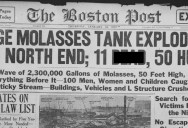The 1919 “Great Molasses Flood” That Turned Boston Into A Sticky Mess
History is full of little oddities, of stories that one would never have guessed could be true, and the time a town was devastated by a food product definitely falls on that list.
It was July 15, 1919 when Boston was hit with an oft-overlooked event of mass destruction – molasses had flooded the city’s streets, leaving a path of wreckage in its wake.

Image Credit: Public Domain
At the time, Boston was home to the Purity Distilling Company, who The built a monumental tank in 1915 to process molasses and, one day, to distill alcohol.
Molasses is used for both commercial and potable alcohol (it’s safe as long as it’s done properly), and this was a major source of revenue for Purity Distilling.
The tank had a capacity of 2.5 million gallons, and it was nearly full on the morning of the incident. Witnesses later recalled that they heard noises comparable to gunshots as the tank’s steel sides and rivets collapsed, releasing a 15-foot wave of molasses from the side of the tank.

Image Credit: Public Domain
So why was it so deadly? Because the density of molasses is about 12 pounds per US gallon. That’s 40 percent heavier than water (roughly 8 pounds per gallon), which results in all of that molasses carrying a lot more energy with it as it made its way through the city streets.
Instead of 16 million pounds of force, the tsunami of molasses unleashed 26 million pounds of sticky calamity on the city. The accident resulted in 21 deaths and 150 injuries, and rescue efforts for those trapped were hindered and stalled due to the sticky nature of the substance.
After helping those affected, the city also had to deal with cleaning up after millions of gallons of molasses.
Later it was revealed that the accident occurred because the company never involved a qualified engineer with the construction of their molasses-holding tank.

Image Credit: Public Domain
The state of Massachusetts took action, passing stricter legislation overseeing construction to prevent similar accidents in the future.
I literally can’t imagine what this would have been like, even though there are obviously photographs that should help.
It sounds like a nightmare – one I’m happy I was not there to witness firsthand.

Sign up to get our BEST stories of the week straight to your inbox.




